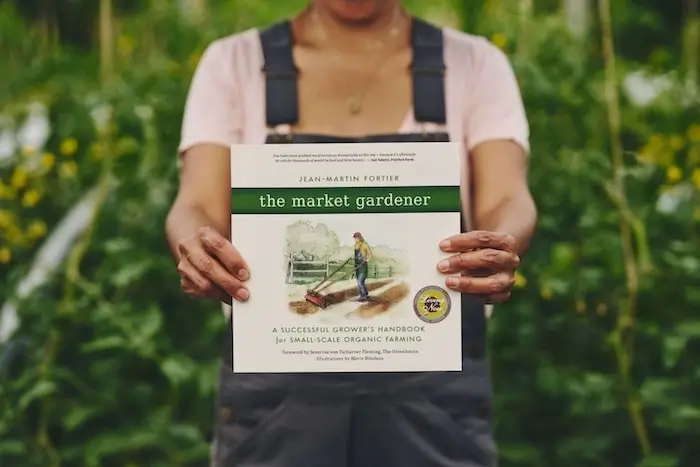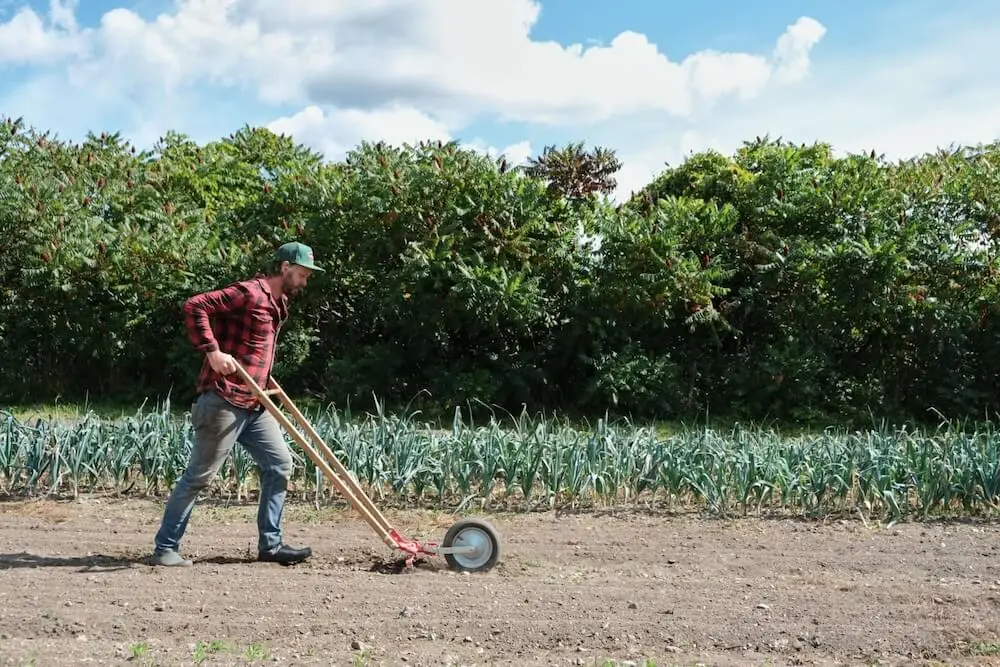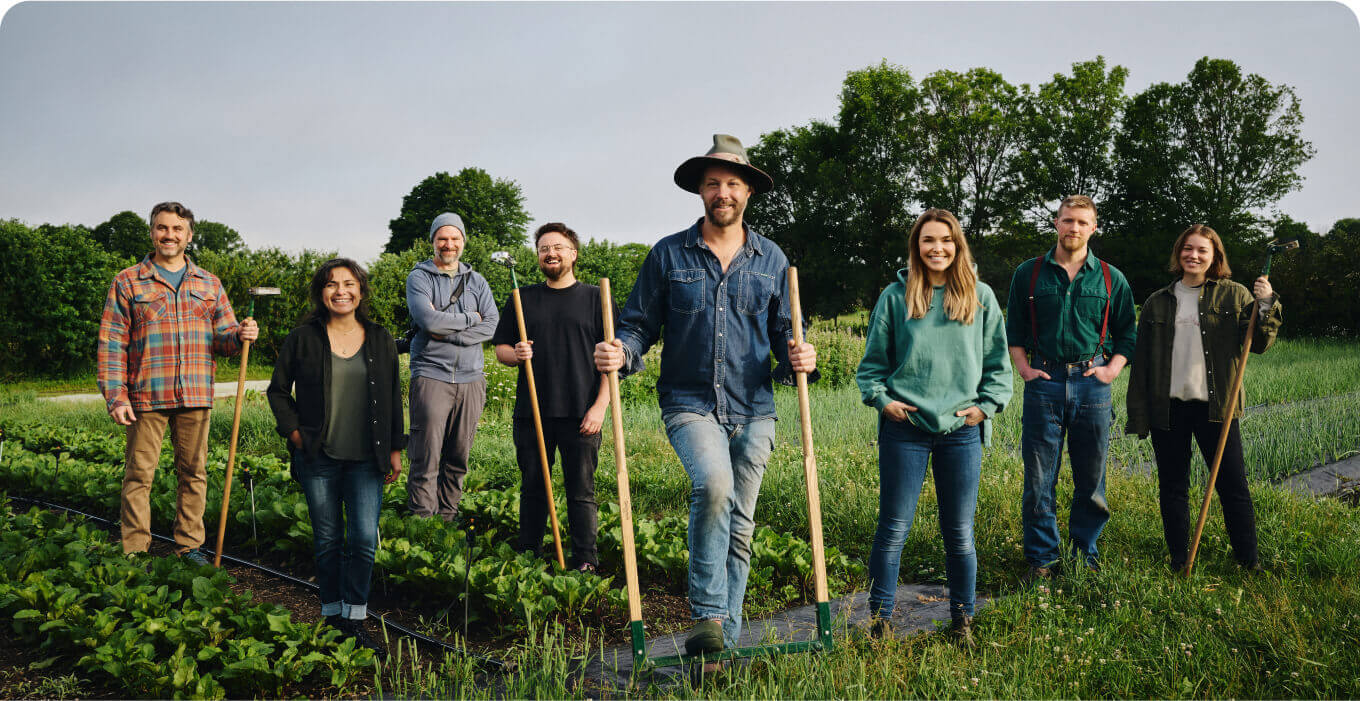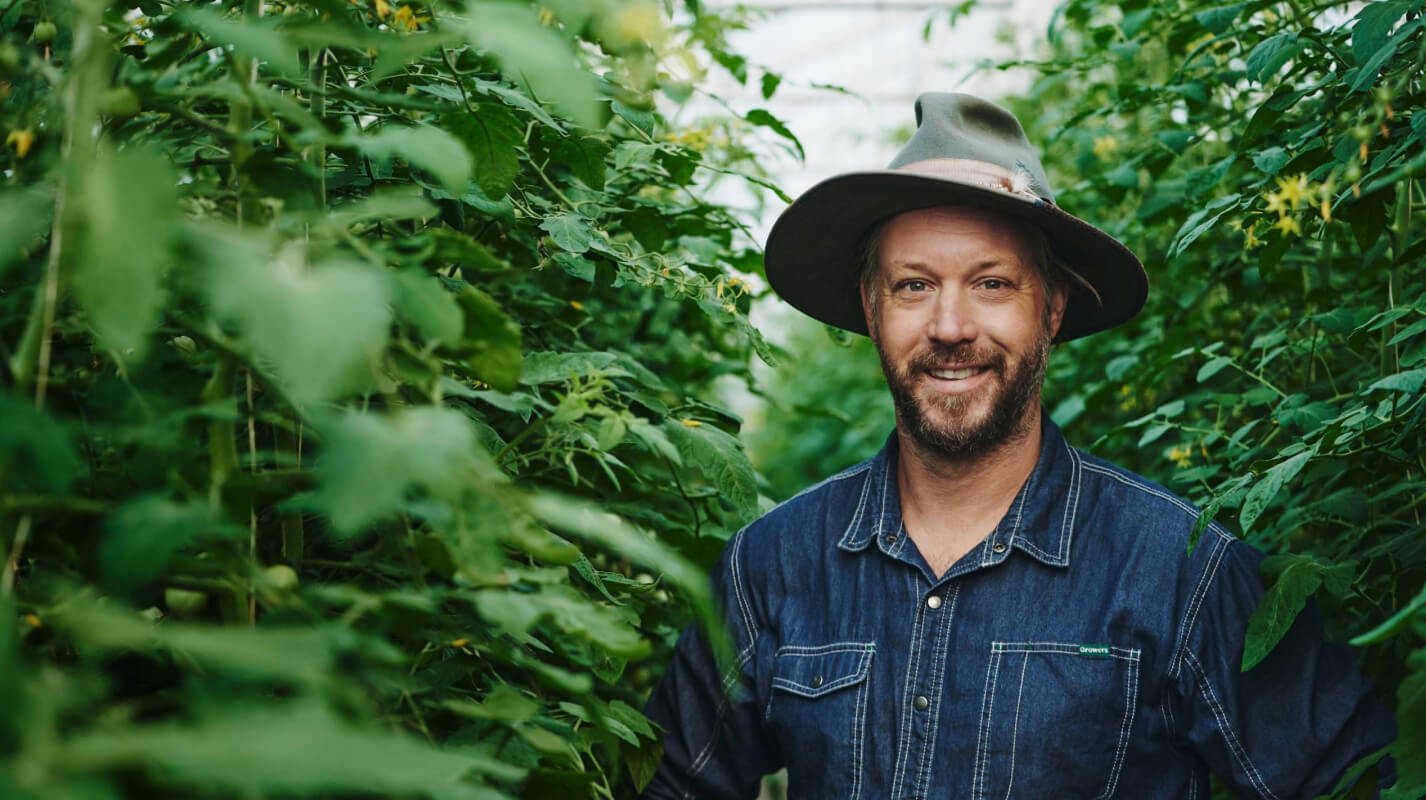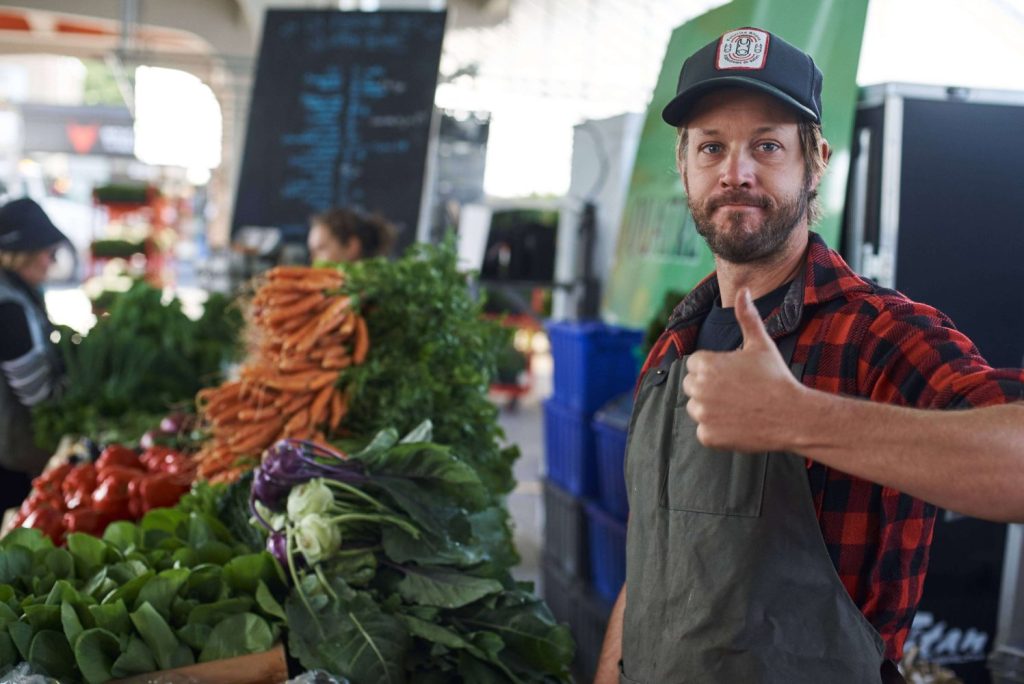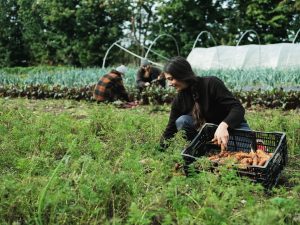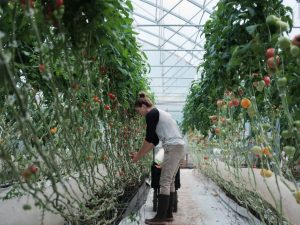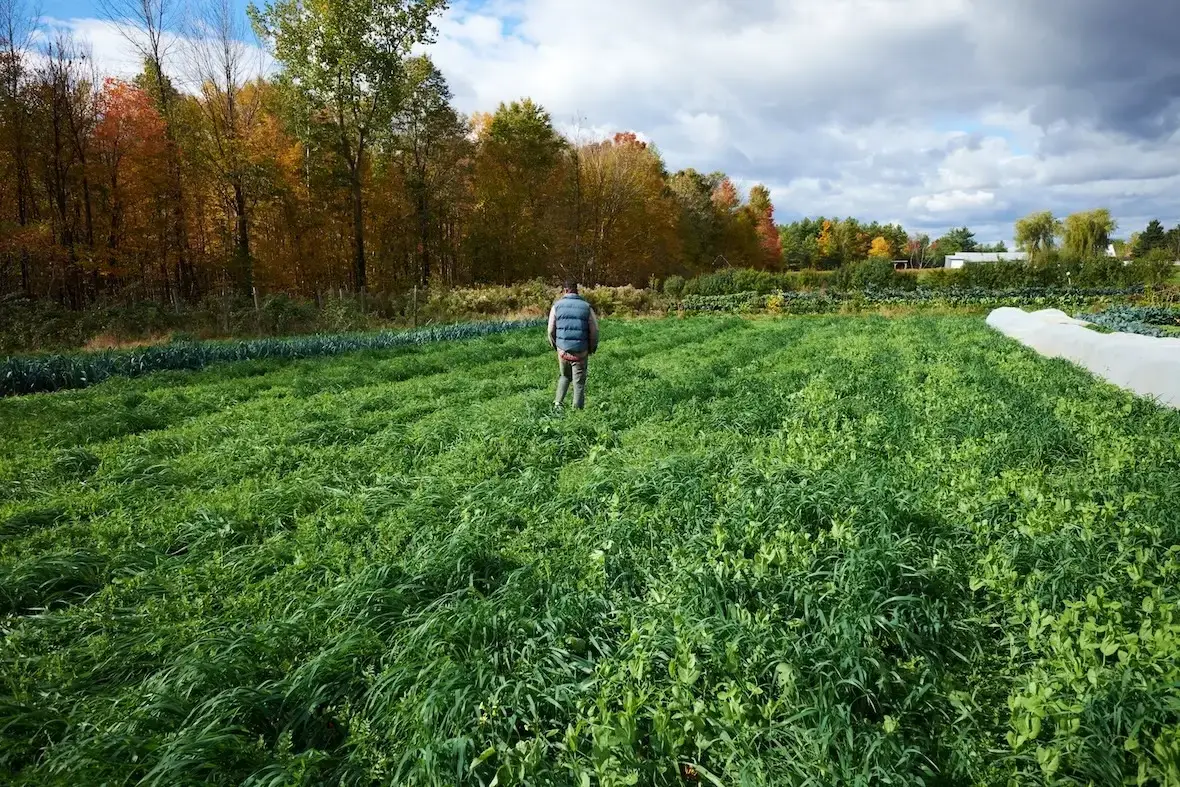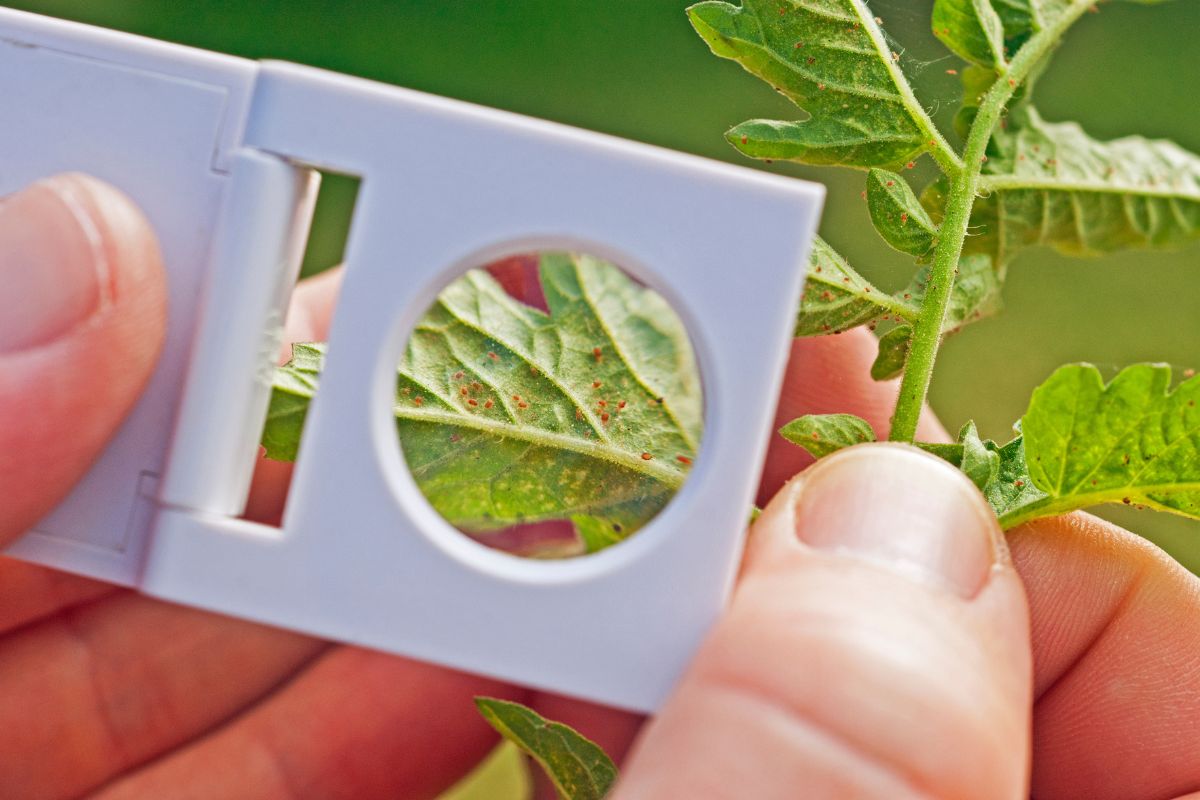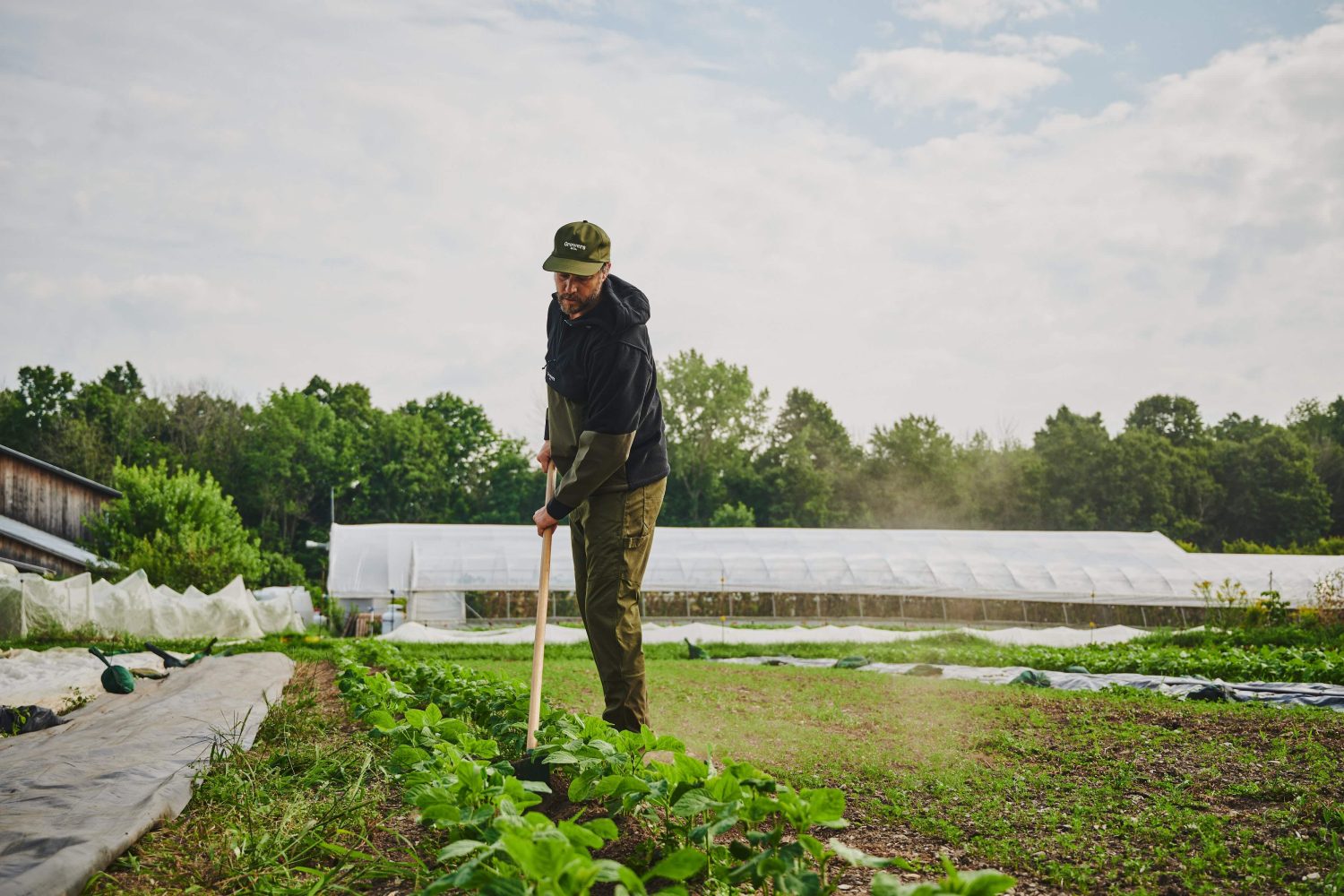What Makes a Crop Profitable?
After decades of trial, error, and obsessive recordkeeping, I’ve developed a simple but reliable method to evaluate the most profitable crops for small farms and biointensive market gardens. This ranking is based on real-world metrics we’ve tracked season after season at La Ferme des Quatre-Temps and Les Jardins de la Grelinette—including $/day/bed, growth rate, popularity, and time investment.
Over the years, I’ve also mentored and consulted with hundreds of growers in different countries, climates, and market conditions. And while every farm has its own ecosystem, I’ve noticed a surprising trend: the same crops tend to rise to the top, whether you’re in Quebec, Oregon, or Western Europe. (Well… except for okra in the Deep South—that one’s a local phenomenon!)
This list reflects the most profitable crops for small farms, not just in theory, but in practice too.
When you’re working with limited land, labor, and time, it’s essential to prioritize crops that deliver high returns, fast turnover, and consistent sales. That’s exactly why identifying the most profitable crops for small farms has become such a critical focus in our approach to profitable market gardening.
This list isn’t about what’s fun to grow or what looks great on Instagram. It’s about what sells, what lasts, and what makes your market garden truly profitable.
Each crop in this guide will include:
- Why does it rank among the most profitable
- Tips and best practices we use to grow it successfully
- My favorite cultivars and where I source them
Whether you’re planning a new CSA, selling at farmers’ markets, or optimizing your crop plan for wholesale, this guide is designed to help you get the most out of every square foot of soil.
Let’s dig into the top 15 most profitable crops for small farms and how to grow them like a pro.
If you’re more of a visual learne, or just want to hear Jean-Martin Fortier walk you through these crops directly, we’ve got you covered.
15. Lettuce Heads
$/Day/Bed: Medium-High | Days to Maturity: 45–60 days | Best Season: Spring and fall
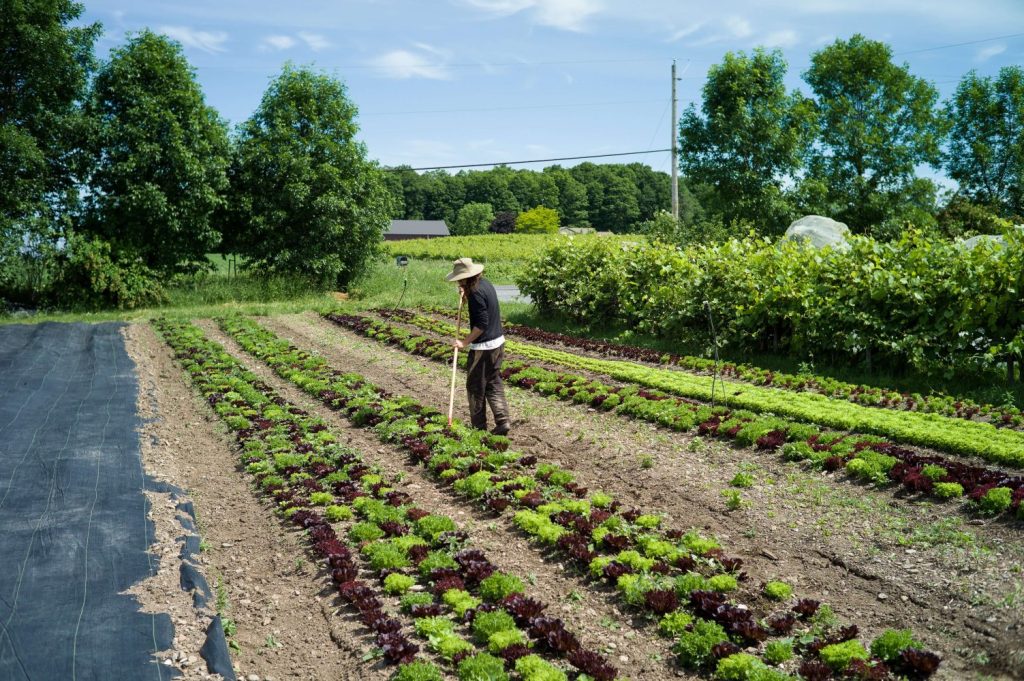
Head lettuce is a staple at farmers’ markets and CSA shares for a reason: it’s beautiful, dependable, and highly valued by customers looking for freshness and variety. They’re a fast turnover crop and offer a strong return when grown with consistency and care. Their visual appeal—crisp leaves, vibrant color, and elegant form—makes them a magnet on the market table. The key to making lettuce work financially is not just in growing it well once, but in having it always available. Week after week, after week, for the whole season. You want people to know you as the salad king, or something like that. Build that kind of consistency, and head lettuce won’t just turn heads at your market stand. It’ll earn its place among the most profitable crops in your market garden.
To make that happen, you need a bulletproof succession system. On my farm, we start new lettuce seedlings every other week without fail. That discipline is what gives us perfect heads at every market, and keeps the crop in our CSA boxes all season long. Timing matters, but so does protection. In spring, we use floating row cover to give transplants a heat boost and speed up growth. In midsummer, shade cloth is crucial to keep plants cool and reduce stress.
“Lettuce doesn’t like surprises: stress it, and it’ll bolt. And if there’s one thing that makes or breaks your lettuce? It’s watering. Frequent, shallow irrigation—especially during head formation—is what gives you those buttery, crunchy, picture-perfect results.”
Harvest early in the morning, when the heads are crisp and full of moisture. A quick dunk in cold water, followed by proper drying and storage in the cold room, will give you a product that keeps beautifully for days. Head lettuce may not be the most profitable crop per square foot—but it becomes a foundation crop when it shows up reliably and looks great week after week. That reliability is exactly what puts it on the shortlist of the most profitable crops for small farms today.
Pro Tip: Group multiple head types—Bibb, romaine, Batavia—in the same bed, and harvest a mixed batch to display as bundles at the market. It catches the eye and elevates the perceived value without extra cost. Variety sells.
14. Field Peppers
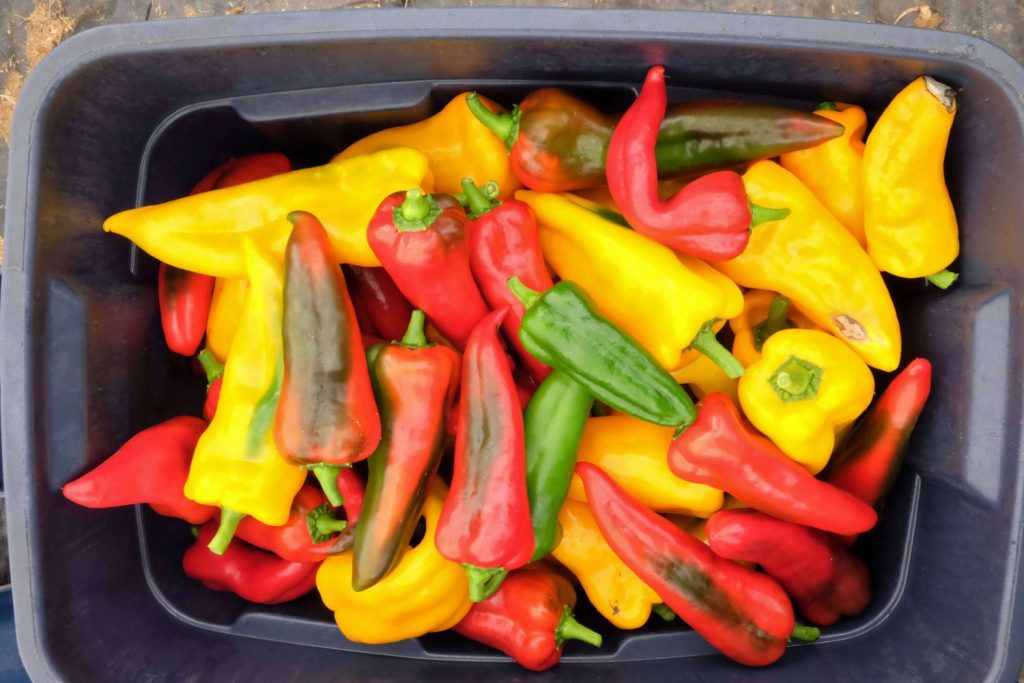
Field-grown peppers are a late-season powerhouse when managed properly. They may take a while to get going, but once they do, the returns are excellent, especially if you treat them like tomatoes. Think trellising, pruning, irrigation, and fertility. Peppers love warmth and consistency. If you can deliver those two things, you’ll be rewarded with dense foliage, heavy fruit sets, and a steady stream of colorful, marketable crops well into the fall.
What makes field peppers profitable isn’t just their yield—it’s the diversity. You can grow sweet bells, frying peppers, lunchbox types, and hot peppers in the same plot, and each one appeals to a different customer. That variety boosts your stand and CSA value. On our farm, we interplant colorful varieties that mature at different times, which spreads out the harvest and avoids gluts.
Start them early indoors and don’t skimp on transplant health. Once they’re in the field, black landscape fabric or plastic mulch is your friend—it warms the soil, cuts down on weeding, and makes harvest more efficient. Peppers need staking once they start to load up with fruit, especially if you’re aiming for premium fruit with good shape. I like to run T-posts every 10–12 feet and weave string between the plants like we do with tomatoes. It adds structure and air circulation, which helps reduce rot and disease.
Fertilize during the vegetative phase, then switch to a fruiting mix rich in potassium once they start setting pods. Water stress is the enemy here—miss a few days, and you’ll get blossom end rot or curled fruit. Keep the soil moisture consistent, especially during fruit development.
“Peppers are like teenagers: they look like they’re doing nothing for weeks, then suddenly explode. Don’t get discouraged early on—just keep feeding them, and they’ll reward you all at once.”
Pro Tip: Harvest peppers when they hit full color for maximum sweetness and market value—but if you’re short on cash flow, start picking them green to keep the stand full and cash rolling in. It’s a balance.
My favorite field pepper cultivars:
13. Field Tomatoes
$/Day/Bed: High | Days to Maturity: 75–90 days | Best Season: Summer
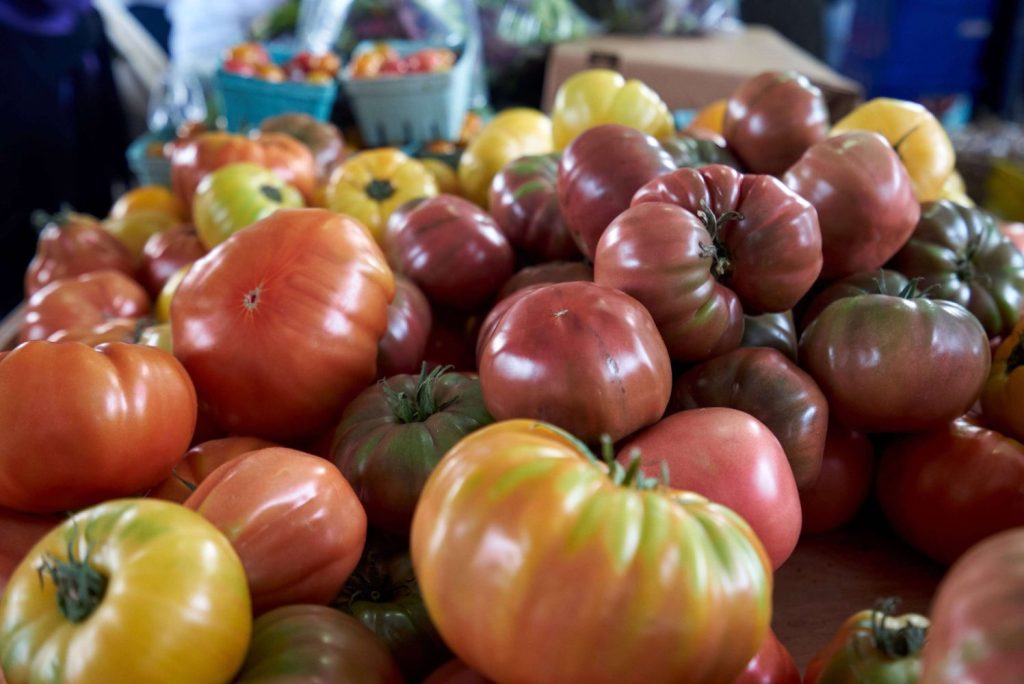
Field tomatoes are one of the most beloved crops on the farm, for growers and customers alike. There’s nothing quite like the taste of a sun-ripened tomato fresh off the vine, and if flavor were the only metric, this crop would be #1. But in our northeastern climate, field tomatoes are a short-lived pleasure. That’s why they don’t rank higher in overall profitability: the window is narrow, and weather can be unforgiving. When it’s good, it’s golden. When it’s not, you can lose half your crop to blight, split skins, or cool nights.
Still, for the 6–8 weeks that they shine, field tomatoes are a showstopper. People will line up at your stand for heirlooms, cherry mixes, or slicing varieties—especially when you harvest them fully ripe. On our farm, we focus on varieties that excel in flavor first. We’re not chasing uniformity or long shelf life. We’re chasing taste. And when you offer that kind of tomato, you build loyalty that lasts all season.
The key is to give these plants every possible advantage: start them early, transplant deep, and trellis them well. We use the Florida weave system with heavy-duty stakes to support our rows. Mulch is non-negotiable. Black plastic or woven landscape fabric helps warm the soil early, conserves moisture, and reduces disease pressure from splashing rain. Drip irrigation under the mulch keeps the leaves dry, which is your best defense against foliar diseases.
Pruning suckers is optional depending on your spacing, but keeping airflow high is not. Harvest frequently—every two to three days—to avoid cracking, especially after a rain. And always pick into shallow bins to preserve the delicate skins. If you’re delivering to restaurants or CSA customers, flavor and presentation will do the heavy lifting for you.
“Don’t treat field tomatoes like a commodity. Treat them like gold, because for two months every summer, they are.”
Pro Tip: Grow a mix of heirlooms and high-performing hybrids in the same block. Use the hybrids as your reliable base, and the heirlooms to build a reputation and buzz at market. One good heirloom can become your farm’s signature.
12. Spinach (for Mesclun)
$/Day/Bed: High | Days to Maturity: 35 days | Best Season: Fall, winter, early spring
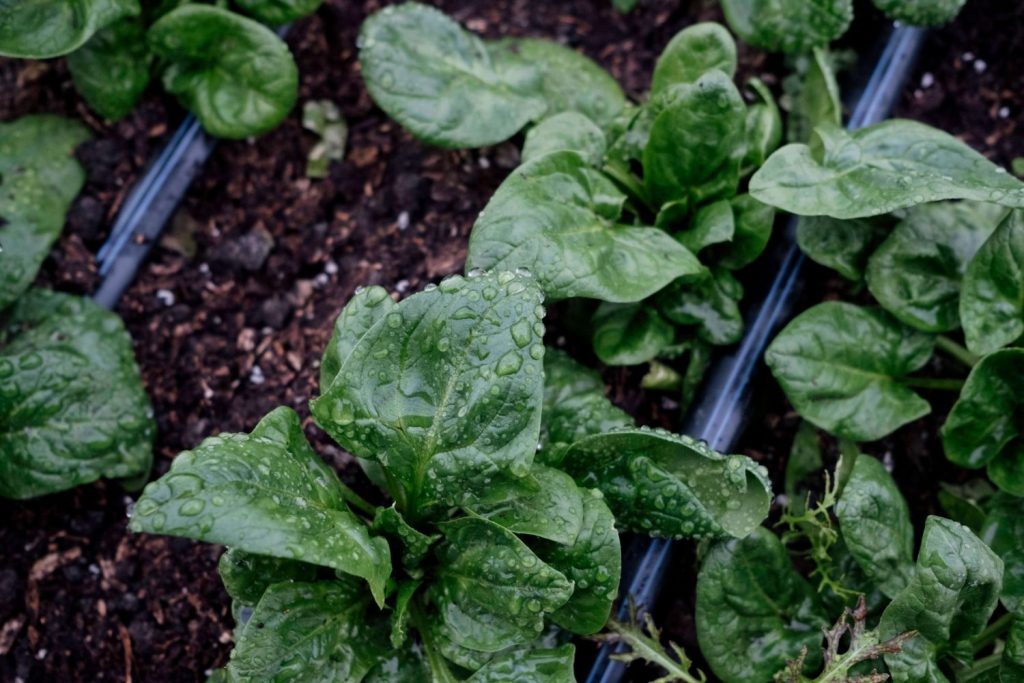
Spinach is one of our most underrated moneymakers—quiet, consistent, and incredibly adaptable. It’s one of the most profitable crops for small farms! While it doesn’t get as much fanfare as tomatoes or mesclun, it’s a reliable winter workhorse on our farm. We grow spinach almost year-round, except for the peak of summer when heat stress and bolting become a battle. The rest of the time—especially from fall through spring—it just performs. It fills CSA boxes, rounds out salad mixes, and brings in steady income at the stand. That makes it a clear candidate for the most profitable crop for small farms aiming for year-round greens.
More and more customers seem to be rediscovering how good real spinach tastes. That rich, earthy flavor and meaty texture make it stand out in a mix or on its own. It’s also one of the few crops that thrives in the cold without protection. But with a low tunnel or greenhouse, you can push spinach deeper into winter than most growers think possible.
We transplant most of our spinach instead of direct-seeding. It’s a little extra work, but it gives us better spacing, more uniform growth, and ultimately, better yields. Transplanted spinach establishes faster, competes better with weeds, and gives us those deep green, perfectly shaped leaves that hold up in the wash station.
The secret with spinach is consistent moisture and quick harvests. We plant thick for baby leaf production—especially when destined for mesclun—and cut just after full leaf expansion. If conditions are good, we can often get two or even three harvests from a single planting. With a well-timed seeding schedule, spinach becomes the backbone of our salad mix for months on end.
“Spinach doesn’t need to be flashy. It just needs to be there. And when it is—week after week—it becomes one of your most dependable assets.”
Pro Tip: For fall plantings, start in open beds, then move under cover in late October. The cold actually sweetens the leaves, and with the right timing, you can cut fresh spinach in December, even in our northern climate.
My favorite spinach cultivars:
11. Beets
$/Day/Bed: High | Days to Maturity: 50-60 days | Best Season: Spring through fall
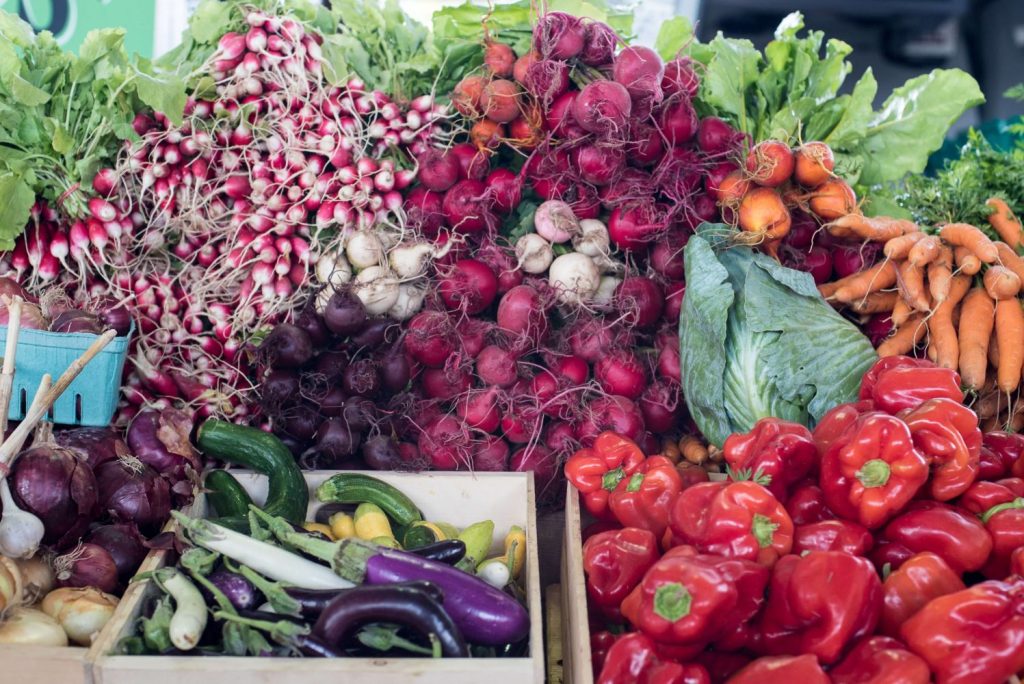
Beets are one of our sleeper hits—quietly moving in big volumes, week after week. What makes them a best-seller on our farm isn’t just the roots, but the beautiful, lush tops that come with them. We always sell our fresh beets with their greens attached, and that’s a game-changer. It tells customers the beets are fresh, it looks stunning at market, and it doubles the perceived value. You’re not just selling a root vegetable—you’re selling a full bouquet of nutrition and color.
We transplant all our beets. This surprises some people, but we’ve found it’s the most efficient way to get ideal spacing, fast establishment, and consistent quality across the bed. With transplants, we avoid the messiness of thinning and get a uniform size that chefs and CSA customers love.
Beets can be grown nearly all season, from early spring into fall, and they’re incredibly versatile. If we don’t sell them all fresh, we simply remove the tops and store the roots for later in the fall. They hold extremely well in cold storage and are easy to include in winter boxes or bulk sales.
To keep the foliage clean and vibrant, we spray preventively for Cercospora leaf spot, a fungal disease that can otherwise wipe out the value of the tops. Our goal is to protect the whole crop, not just the root, and that’s where beets really shine. With both parts in top condition, they compete head-to-head with carrots as one of our most valuable root crops.
“Sell your beets like flowers. With lush tops, tight bunches, and vibrant colors—they’ll always catch a customer’s eye.”
Pro Tip: Space your transplants to match your bunching needs—5 to 6 evenly sized beets per cluster is the sweet spot. If they’re too tight, they get crowded and misshapen. If they’re too loose, you lose yield.
You can learn more about how I grow beets in this video :
My favorite beet cultivars:
10. Radishes
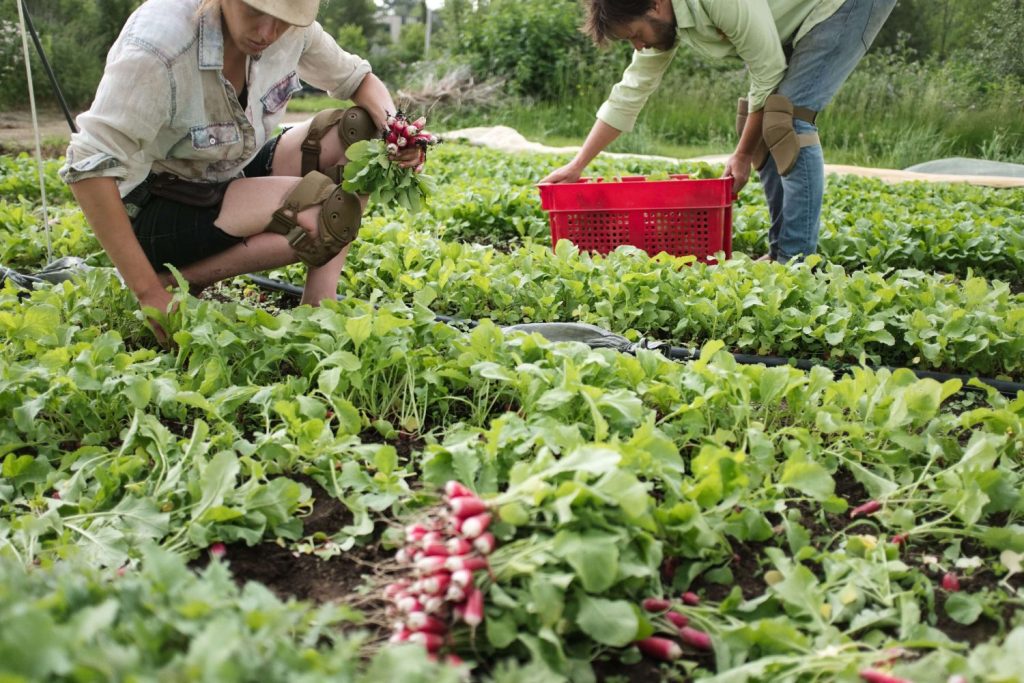
Radishes might be the best crop to grow in early spring—hands down. They’re fast, easy, and incredibly profitable when you time them right. At La Grelinette and FQT, we grow them in huge quantities in March and April, beating everyone else to the punch. Showing up at the first farmers’ markets of the season with beautiful radishes, while other growers only have spinach, is a serious competitive edge. We favor eye-catching varieties with bright colors, crisp textures, and uniform size. When displayed in bunches, they turn heads and sell fast.
They also happen to grow better—and taste better—in cool weather. In fact, that’s one of the only things keeping radishes from ranking even higher on this list: once the summer heat arrives, quality declines. Roots get pithy, spice increases, and consistency drops. If we could grow the same flawless radishes in July as we do in April, they’d be a top-five crop without question. But for two seasons—spring and fall—they’re golden.
We sow in dense bands (usually 10 rows per 30″ bed), and harvest right at peak size to ensure crisp texture. They’re bunched quickly in the field and dunked in cold water immediately after harvest. We never wash them aggressively—just enough to remove the soil, not the bloom.
Pro Tip: For serious spring revenue, stagger three early seedings just 7–10 days apart. This gives you a steady stream of picture-perfect radishes to dominate the first month of farmers’ markets and early CSA boxes. And don’t forget to mix varieties—rainbow bunches sell themselves.
My favorite radish cultivars:
9. Arugula
$/Day/Bed: Very High | Days to Maturity: 30–40 days | Best Season: Spring and fall
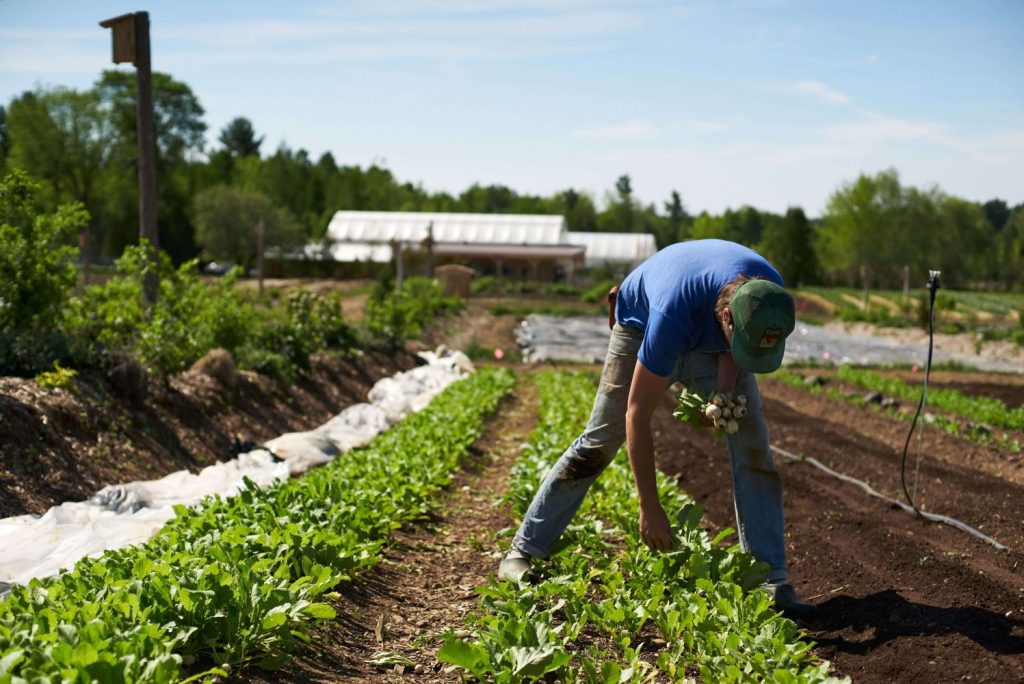
Arugula is an early spring favorite, right alongside radishes. At that time of year, it grows beautifully and abundantly. We seed it densely—12 rows per bed—and get more than two or three high-quality cuts per planting when conditions are right. Spring arugula is tender, vibrant, and packed with flavor. Our bumper harvests during those early markets are always a hit. People love the peppery bite, especially chefs and CSA members looking for that first burst of green after winter.
Like radishes, we stop growing it once the heat kicks in. Sure, we could still sell it in the summer, but the taste becomes too pungent and aggressive for most palates. We bring it back in the fall, when cooler weather improves the texture and mellows the flavor again, making it one of the most reliable shoulder-season greens on the farm.
We harvest using the quick-cut greens harvester, which makes the job easy, as long as the blade is razor sharp. Without that, you’ll just tear the leaves and ruin the crop. Arugula might not be the flashiest crop, but when grown well and timed right, it’s incredibly productive and always sells out fast.
Pro Tip: To get a smooth harvest and regrowth, make sure the harvester blade is freshly sharpened before every cut. A clean cut = a clean regrow.
My favorite arugula cultivars:
8. Carrots
$/Day/Bed: High | Days to Maturity: 75-85 days | Best Season: Early spring through late fall
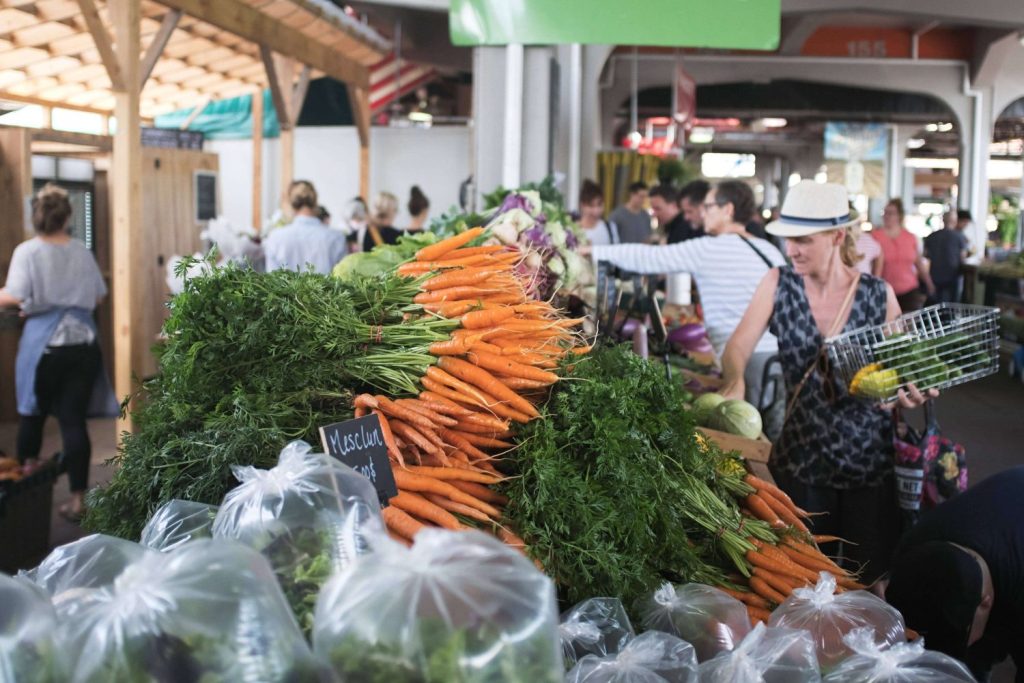
Carrots are a foundation crop in our rotation, and over the years, they’ve become one of our most consistent money-makers. That’s why they earned a place in our list of the most profitable crops for small farms. But their success depends on two things: early harvests and uninterrupted supply. That means having carrots at your stand or in your CSA box every single week for months on end. To make that happen, we follow a strict calendar and sow carrots every two weeks from early spring to late summer—often 12 to 15 successions in total. The earliest ones go into protected tunnels as soon as February, giving us a head start that beats other growers to market and sets us up for early spring sales.
The other key to carrots is weed control. They’re slow to germinate, and weeds will outpace them quickly if you’re not prepared. Our trick? Flame weeding. We prepare the bed and water it like normal, then wait until the first weeds begin to sprout, just before the carrots emerge. Then we pass a flame weeder over the bed, torching the tiny weed seedlings without disturbing the soil. It’s a game-changer and one of the best tools in our playbook for clean, uniform stands.
Once carrots are up, they’re relatively low-maintenance. We thin them for ideal spacing, irrigate deeply, and harvest either for fresh bunches or bulk storage depending on the season. Fall carrots get even sweeter with a touch of frost and store beautifully for winter sales. For us, carrots aren’t just a crop—they’re a signature product that brings people back week after week.
“Get carrots to market first, and then never let them disappear. That’s how you own the category.”
Pro Tip: Seed early and often, but also plan your storage. A reliable cold room allows you to stockpile carrots in the fall and stretch the sales window well into winter, without sacrificing quality.
Check out how to make perfect bunches of carrots here:
7. Hakurei Turnips
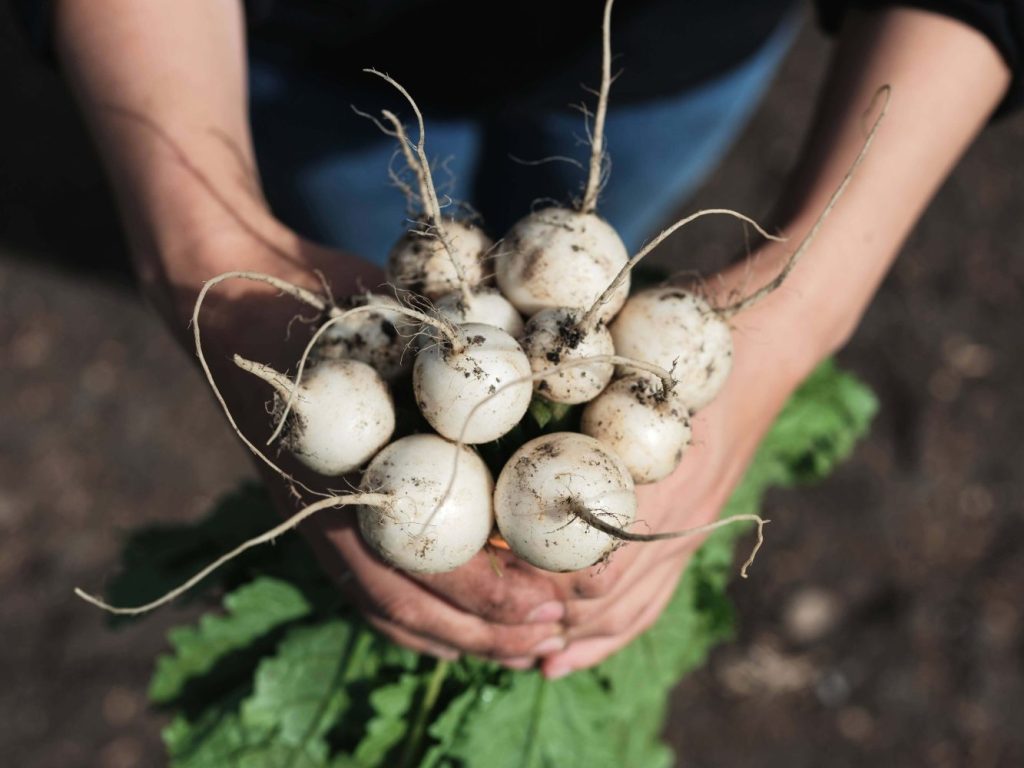
If there’s one crop that surprises people at the market, it’s Hakurei turnips. These salad turnips are sweet, juicy, and tender enough to eat raw—nothing like the woody storage turnips of the past. Once customers taste them, they become instant fans. For us, they’ve become a spring and fall staple and one of the few crops where we consistently sell both the root and the greens. That double yield, plus their short time to maturity, makes them a smart, high-rotation crop for any intensive grower.
We transplant Hakurei for optimal density and uniformity, setting five rows per 30-inch bed with about 1.25″ spacing. That tight layout allows us to maximize yield per bed foot, and the uniformity makes harvest quick and efficient. Since this crop thrives in cooler weather, we focus our production windows early in the spring and again in the fall. In our climate, we can’t grow them well in summer—the heat makes them bitter and pithy—but when the timing is right, they’re unstoppable.
Preventive protection is essential. We start by covering our beds with insect netting immediately after transplanting to keep out flea beetles and leaf miners—two pests that can quickly destroy the tender green tops. If the foliage gets riddled with holes or trails, the entire bunch loses appeal and value. But when the tops stay clean, crisp, and vibrant, and the white roots are perfectly formed—that’s when Hakurei turnips become one of the most beautiful and profitable crops on the table.
“Treat the greens like they matter just as much as the roots—because they do. That’s how you sell a $5 bunch instead of a $2 one.”
Pro Tip: Always harvest Hakurei at 2–3″ diameter. Any bigger, and you risk losing that melt-in-your-mouth texture. Monitor beds daily at maturity—you’ll be surprised how fast they size up.
My favorite hakurei turnips cultivars:
Free Workshop for High-Efficiency Growers
If you’re looking to increase your performance—whether through tighter successions, higher yields, or more efficient post-harvest workflows—don’t miss our free workshop: Growing Crops That Pay Off Quickly.
You’ll learn practical techniques to maximize every field bed with crops that mature fast, sell out quickly, and bring in consistent income. From succession planting strategies to increasing yield and maintaining quality through the season, this free session is designed to help small-scale growers get real results—fast.
6. Greenhouse String Beans
$/Day/Bed: Very High | Days to Maturity: 55-65 | Best Season: Early spring through late fall
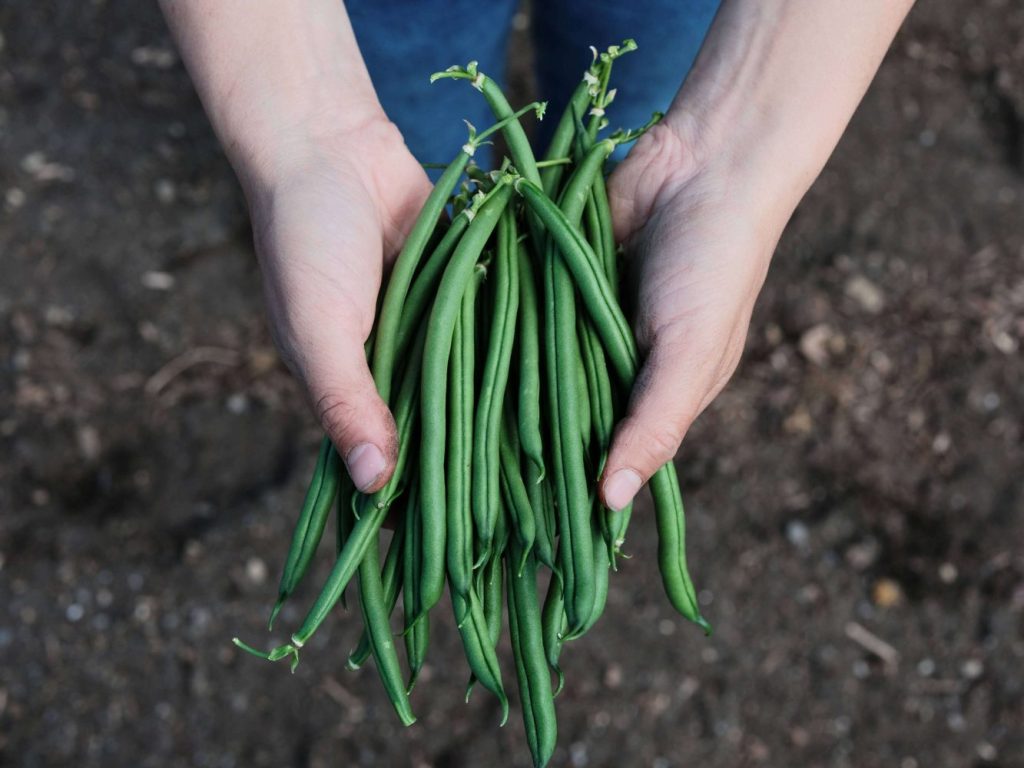
String beans might not be the first crop that comes to mind when you think of greenhouse production, but for us, they’ve become a quiet powerhouse. We grow them nearly 10 months out of the year, and they’ve become a cornerstone of our supply to restaurants and specialty grocers. The demand is there, as long as you can guarantee quality, freshness, and consistent volume. With proper greenhouse management, that’s exactly what we deliver and why it ranks as one of the most profitable crops in the market garden.
These beans are a labor-intensive crop, no doubt about it. The plants are prolific and need to be harvested every other day at the peak of production. But if you have a market willing to pay for freshness—and we do—the returns more than justify the effort. The secret is in the trellising. We train them vertically along sturdy mesh or string, creating a wall of beans that’s easy to manage and maximizes airflow and light penetration. This keeps the plants healthy and speeds up picking.
In cooler months, the greenhouse keeps them growing strong when field production shuts down. In hot spells, we ventilate aggressively to avoid heat stress and keep the pods tender. Harvest timing is key: pick before the pods fill out too much to maintain the delicate snap and sweet flavor customers expect. With good fertility and consistent irrigation, we can keep the crop cycling nearly all year.
“Greenhouse string beans are a high-touch crop—but when you hit the mark on quality and consistency, the price per pound makes it all worthwhile.”
Pro Tip: Stagger your plantings every 6-8 weeks inside the greenhouse to maintain a continuous harvest window. This way, you’re never without beans during peak restaurant demand—even in March.
My favorite greenhouse string beans cultivars:
5. Greenhouse Cucumbers
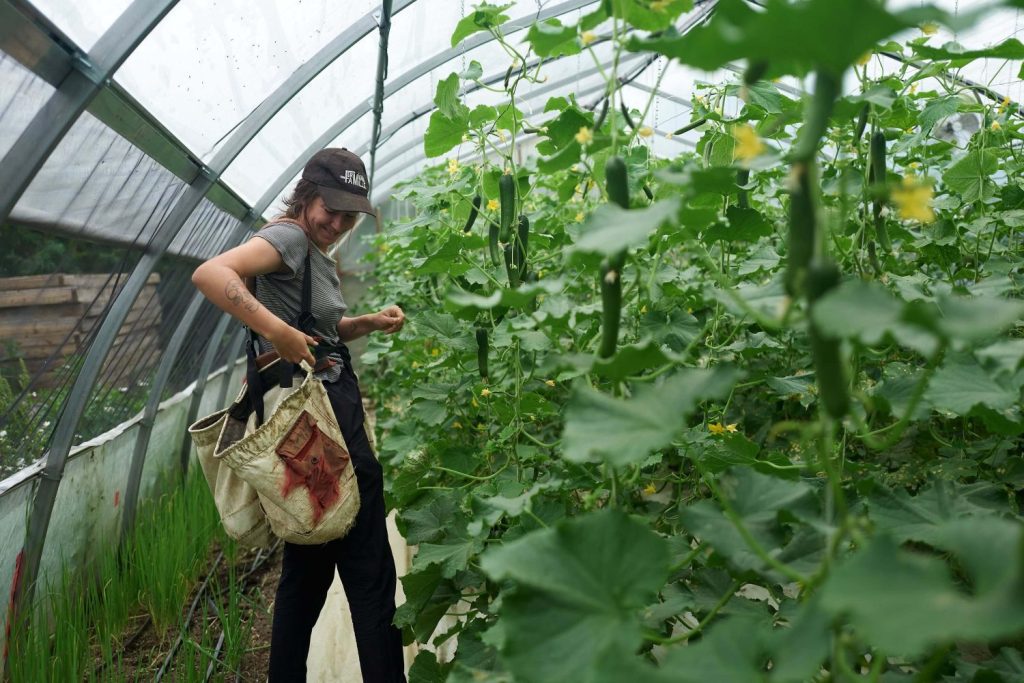
Greenhouse cucumbers are a staple in our protected-culture lineup, and for good reason: they produce heavily, look flawless, and command excellent prices when grown right. With high-wire trellising and parthenocarpic varieties, we’re able to harvest sleek, sweet cucumbers every 2–3 days over a long production window. Their uniformity and crunch make them a chef’s favorite, and our CSA members love how long they keep in the fridge.
The key to turning cucumbers into a consistent money-maker is setting them up for success from the start. We plant in deep, compost-rich beds and train vines vertically using string and clips. That structure not only saves space but also improves air circulation, reducing disease pressure and making harvests easier. Pollination isn’t needed with parthenocarpic types, which keeps labor low and results high. We apply potassium-rich fertilizer during fruiting and maintain tight irrigation schedules with drip tape.
Like string beans, this is a crop that rewards attention. You need to be in the tunnel every 48 hours for picking—miss a day, and the fruits balloon past market size. But when you stay on top of it, the returns are impressive. One 100-ft bed can produce hundreds of market-ready cucumbers every week for months.
“The best cucumbers are crisp, consistent, and picked just in time. In the greenhouse, that means rhythm. Get in, harvest fast, and never let one go yellow.”
Pro Tip: Double your cucumber income by growing two types side-by-side—English slicers and Lebanese minis. Offer them in mixed boxes for chefs and small packs for CSA shares. The variety adds value without increasing complexity.
To see exactly how we trellis greenhouse cucumbers for maximum yield and ease of harvest, check out this video :
My favorite greenhouse cucumber cultivars:
4. Garlic
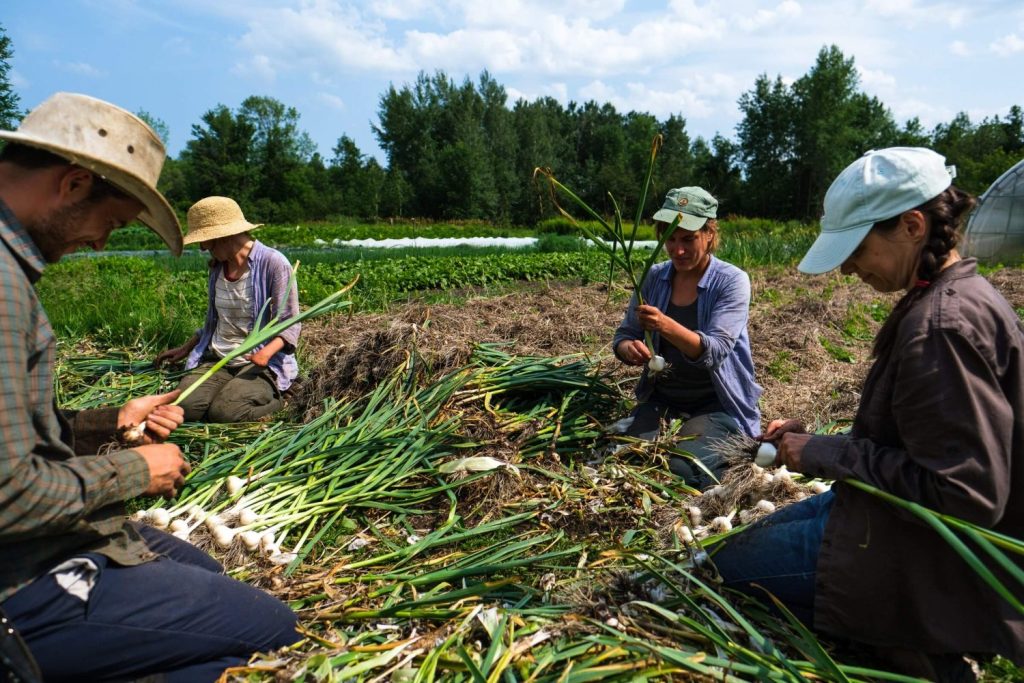
Garlic is the ultimate “money-in-the-bank” crop. Planted late in the fall, harvested the next summer, and cured properly, it becomes a shelf-stable, high-demand product you can sell for up to six months of the year. And people love good garlic—especially when it’s local, fresh, and flavorful. We’ve built a reputation around it, and it’s a crop that now supplies not only our CSA boxes and market stand, but also several restaurants and chefs who count on our consistency and quality. In many ways, it’s become one of the few crops we semi-specialize in—and it pays off.
For growers aiming to expand their off-season revenue, garlic consistently proves to be one of the most profitable crops for small farms due to its shelf life and low post-harvest labor!
We grow hardneck garlic for its superior flavor and better storage performance. It’s a low-maintenance crop once it’s in the ground, but doing it right means following a system. We devote an entire block to garlic in our rotation and treat it as a major player, not a side hustle. Clove selection is critical: only the firmest, biggest, and healthiest cloves get planted. Beds are prepped with compost, broadforked, and loosened to two inches deep. We plant our cloves just over an inch deep and space them intensively—three rows per bed, spaced 10 inches apart, with 6 inches between cloves. A thick mulch of straw (4–6 inches) protects the beds from early freeze and gives the roots a head start before winter.
In spring, we pull back some of that mulch to help the soil warm and prevent excessive moisture buildup. Garlic hates weeds, so we keep beds clean and monitor closely. Around mid-June, scapes appear—those curly flower stalks that signal the bulbs are bulking up. We harvest them a few times a week and sell them early in the season, when they’re a novelty at market and add flavor diversity to early CSA shares.
Harvest timing is crucial. Too early and you lose protective wrappers. Too late, and the bulbs split. Our rule: harvest when 30% of the leaves have yellowed. We clean the bulbs in the field by removing the first leaf (easier pre-cure), trimming roots, and laying them on landscape fabric to dry in the sun. At the end of the day, they move inside onto stacked drying racks with ventilation and fans. Full curing takes about three weeks. Once cured, we trim the necks and store the bulbs in mesh bags in a cool, dry place. A well-cured garlic bulb will keep for 6–8 months or longer.
Healthy garlic comes from healthy seed. Don’t save cloves from questionable bulbs—rot often comes from viral infection, poor drainage, or improper curing. When in doubt, buy certified disease-free seed garlic from reputable growers. It costs more up front, but it’s worth it.
“Garlic stores value like few other crops. Cure it right, and you’ll have a high-priced product flying off the table long after the rest of the harvest is gone.”
Pro Tip: Make it a party. Every year, we organize a big garlic harvest day and invite friends, family, and CSA members. With a good crew and a clear system, we pull, clean, and lay out thousands of pounds in a single afternoon. It builds community and gets the job done fast.
My favorite garlic cultivars:
3. Cherry Tomatoes (Greenhouse)
$/Day/Bed: Exceptional | Days to Maturity: 70–85 days | Best Season: Summer to early fall
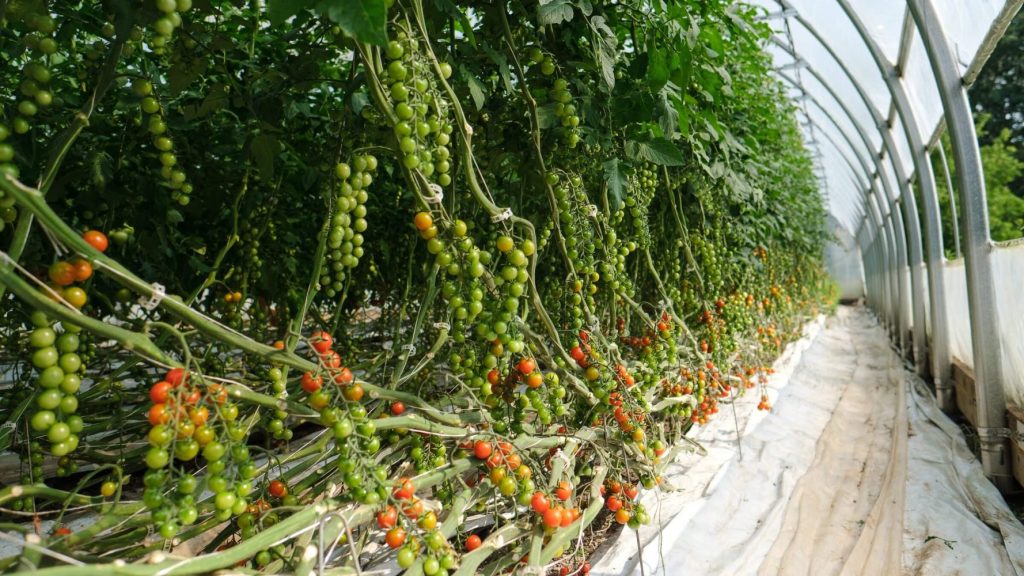
If there’s one crop that delivers beauty, flavor, and money in one neat little package, it’s cherry tomatoes. Grown under protection and harvested at peak ripeness, they consistently fetch $8–$12 per pound at farmers’ markets and with restaurant clients. At those prices, you don’t need to move massive volumes to make serious income. With consistent pruning and trellising, a single 100-foot bed can yield hundreds of pounds over the course of the season.
On our farm, cherry tomatoes are the most popular fruiting crop after greenhouse slicers. We grow them on high-wire trellises in our tunnels, allowing us to harvest for several months in a row without sacrificing quality. The trick is to manage airflow and vigor: we prune to a single or double leader depending on the variety and greenhouse spacing, and we remove lower leaves as the fruiting trusses mature to keep disease pressure low.
We start the plants early indoors and transplant them into warm, compost-rich beds once soil temperatures are ideal. Fertility needs are moderate, but balanced—too much nitrogen and you’ll get jungle vines instead of fruit. We fertigate weekly, monitor for spider mites and whiteflies, and use biological controls to maintain balance.
Cherry tomatoes need frequent harvests—every two to three days once they hit peak production. That’s labor-intensive, but it’s also part of why they’re so profitable. A fresh, colorful pint of cherry tomatoes is irresistible on a market table, and when customers get used to your flavor-packed product, they come back week after week.
“Cherry tomatoes might be the highest return per hour you can get in a greenhouse—if you do it right.”
Pro Tip: Always grow multiple colors and shapes together—red, orange, yellow, grape, round, and pear. It increases the visual appeal, makes your pints look gourmet, and lets you charge a premium without adding complexity to your harvest workflow.
My favorite greenhouse cherry tomatoes cultivars:
2. Mesclun (Lettuce Mix)
$/Day/Bed: Very High | Days to Maturity: 60–85 days | Best Season: Spring through fall
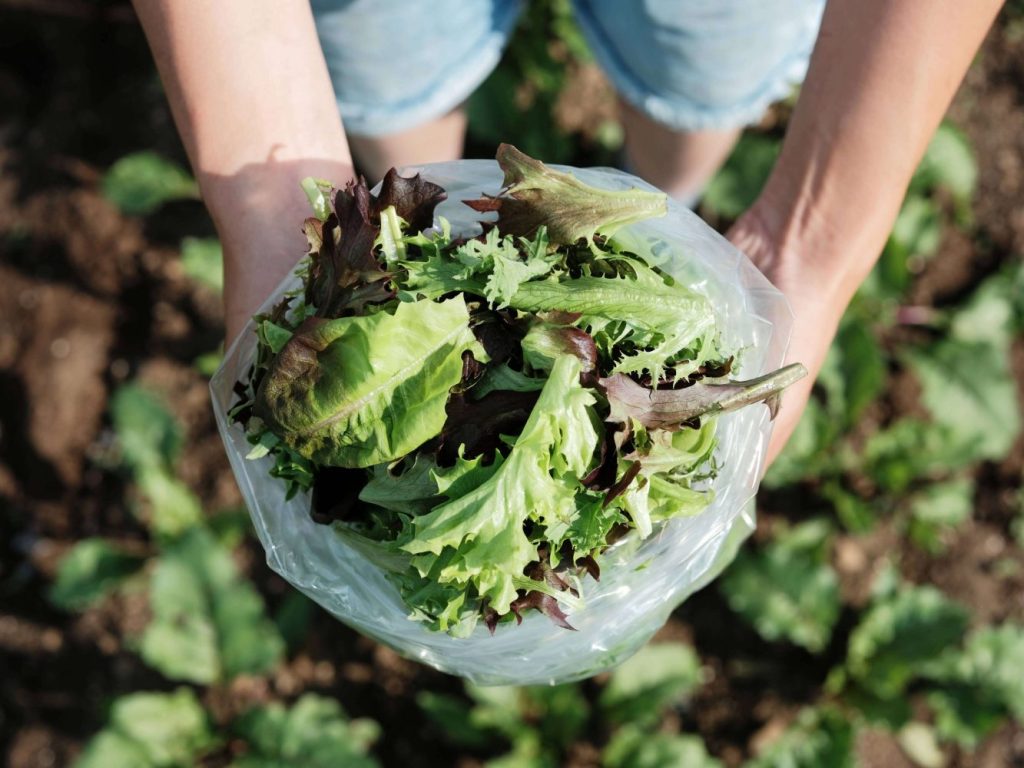
Mesclun is the backbone of our salad production—and one of the highest-earning crops per square foot on the farm. We grow dense beds of Salanova lettuce and harvest them young, tender, and vibrant. When washed and packed properly, this mix commands a premium at market and moves in volume. On a good week, we’ll move over 300 bags between our CSA, stores, and restaurants. With numbers like these, it’s easy to see why mesclun ranks among the most profitable crops in a market garden.
What makes mesclun so lucrative is how often we can turn the beds. With good fertility and quick-cut harvest tools, we usually get 2–3 full cuts per planting. Our spacing is tight—12 rows per 30-inch bed—and we direct seed about 2.5 oz per 100-ft bed. Every step of the process, from germination to bagging, is streamlined to reduce labor and maximize quality.
Timing is everything. We seed every 10–14 days throughout the season to ensure an uninterrupted supply. In hot spells, we use shade cloth to slow growth and avoid bitterness. In cooler months, floating row covers help push the shoulder seasons. We’re religious about harvest timing—always early morning—and we cool the greens immediately in the wash station to lock in quality.
A well-grown bed of mesclun is pure satisfaction. It looks clean, feels substantial in the hand, and practically sells itself when displayed well. You don’t need 20 salad ingredients—just a great mix of buttery leaves and crisp textures that hold up in a bag.
“Nothing says professional market gardener like beautiful mesclun—grown clean, cut quickly, and bagged like gold.”
Pro Tip: Grow mesclun on landscape fabric—not just to control weeds, but to keep your salad mix clean, free from rocks and debris, and ready for market. And when it comes to washing? A bubbler is not optional. Crisp, clean greens are what set you apart.
Bonus: To boost your harvest speed and consistency, you should invest in the Quick Cut Harvester. This tool is a game-changer for baby greens. It dramatically reduces harvest time, delivers cleaner cuts, and improves product uniformity. While the upfront cost may seem steep, it pays for itself in a single season through saved labor and faster turnaround.
What Is a Quick Cut Greens Harvester?
The Quick Cut Greens Harvester (QCH) is a small tool made of a blade that moves horizontally and is activated by a drill. The blade cuts the greens at the height desired by the operator while strips of rope turn and place the leaves in the basket. It was invented by Jonathan Dysinger and is sold by Farmers Friend. This tool can be used to harvest baby greens like kale, mustard, arugula, spinach, etc.
My favorite mesclun cultivars:
1. Greenhouse Tomatoes (Heirloom-Type Slicers)
$/Day/Bed: Exceptional | Days to Maturity: 75-90 days | Best Season: Early summer to fall
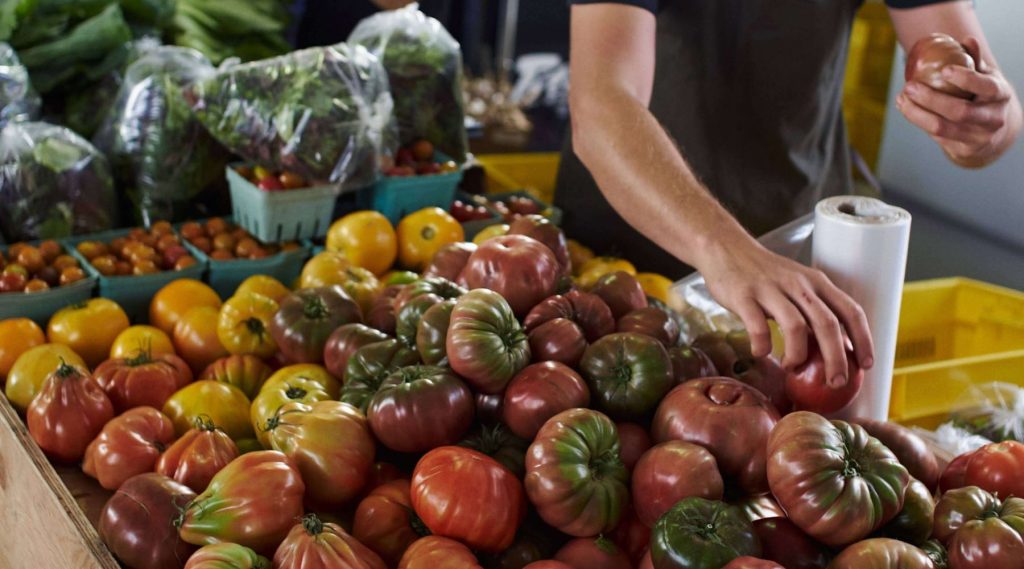
This is it—the king of the greenhouse, the number one on this list of the most profitable crops for small farms. Tomatoes are the single most profitable crop we grow, and when managed properly, they’re in a class of their own. We’re talking $15,000 to $40,000 per 100-foot bed over a full season. That kind of revenue only happens with tight systems, consistent quality, and a product that customers go crazy for.
We focus on heirloom-type slicers: tomatoes that look and taste like true heirlooms but perform like modern workhorses. These varieties are ideal for high-wire systems in tunnels, offering great flavor, bold colors, and impressive yields with far better disease resistance and shelf life than true heirlooms. They are the heart of our tomato strategy and the reason chefs, CSA customers, and grocery partners come back season after season.
We grow them vertically on string trellises, pruning to a single leader, and remove lower leaves weekly to boost airflow and reduce disease risk. Drip irrigation and frequent potassium feeding keep the plants balanced, while trellising clips allow us to maintain the structure of rows over 8–9 months. We harvest twice weekly, often for nearly half the year, and always pick fruit fully ripe on the vine—that’s where the flavor magic happens.
“Greenhouse tomatoes aren’t just a crop, they’re a brand. When you’re known for them, people show up early at the market just to get their hands on your baskets.”
Pro Tip: Grow on black woven landscape fabric to suppress weeds and maintain soil warmth early in the season. And don’t skip the lower leaf pruning—it’s one of the best ways to stay ahead of blight in a long harvest window.
To learn more about how I grow tomatoes in the greenhouse, check out this video:
Grow Smart to Grow More
The key to a profitable market garden is not growing more crops. It’s about growing the right crops, at the right time, in the right way. These are my 15 most profitable crops for small farms that perform exceptionally well under biointensive, small-scale conditions. But your own success will depend on understanding your market, managing your time, and tracking your performance.
The more you refine your system, the more productive and profitable your garden becomes.
Focusing on the most profitable crops for small farms isn’t just smart, it’s essential if you want to make the most of limited space, time, and labor.
Ready to take the next step?
If you’re serious about improving your field production, check out our course 8 Most Profitable Field Crops, where you’ll learn how to produce 8 efficient vegetables designed for continuous harvest and consistent income.
But if you’re looking to maximize your success inside a greenhouse, our Mastering Greenhouse Production course will guide you through everything from choosing the right structure to managing fertility, pests, and crop planning for high-yield greenhouse success.
Both programs are packed with practical strategies, proven techniques, and years of experience, designed to help small farms like yours thrive.

